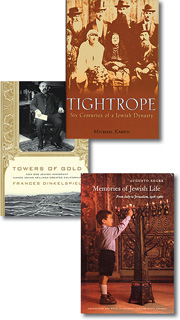Diana Brement
JTNews Columnist
Three different family stories spanning centuries and continents give us a personal lens with which to look at Jewish history. We can follow one family through six generations, spend the 20th century peeking into Italian Jewish life before and after World War II, or travel to the new world with the man who was instrumental in California’s financial success.
Tightrope: Six Centuries of a Jewish Dynasty (Wiley, cloth, $35, 420 pages) by Israeli journalist Michael Karpin tackles the story of the Backenroth family, whose tale echoes the history of central European Jewry. When Brazilian businessman Allan Kahane asked Karpin to write the story of his Holocaust-survivor father, Israel, the journalist was not impressed. But when Kahane revealed he had records of his family dating back to the Middle Ages, Karpin became intrigued. The real story was on Kahane’s mother’s side — a fascinating account of a family’s journey through history.
Based on diaries, letters, documents and oral history, the book opens in the mid-1300s as the family, escaping plague and blood libel, flees to the sparsely settled eastern frontiers that would eventually become Poland and Russia. Through 20 years of research and interviews that took him around the world, Karpin uncovered the story of this family which includes Torah scholars, oil barons, a Holocaust hero who saved hundreds of Jews, and a convert to Islam who was instrumental in the founding of Pakistan.
Still in Europe, and focusing on the 20th century, is Augusto Segre’s interesting and engaging Memories of Jewish Life: From Italy to Jerusalem, 1918-1960 (Nebraska, cloth, $40, 507 pages).
Segre, who died in 1986, was a well-known teacher and scholar in Israel, the author of nine other books. This memoir, originally written in Italian, is beautifully translated by Steve Siporin with a moving foreword by the author’s children.
In the opening chapter, appropriately called “Once Upon a Time,” Segre captures the near-fairy tale ambiance, the warmth of tradition that cloaked the Jewish community of Casale Monferrato where he grew up. The innocence of his young childhood slowly fell away during his school years as he became aware of anti-Semitism and anti-Zionism springing up in the surrounding community. His parents — his father was a rabbi — and their friends struggled first politically against Italian fascism and then as partisans against the Nazi occupation. After the founding of Israel, Segre made aliyah, along with most Italian Jews.
“On two improvised beds,” he writes of that journey from Italy to Israel, “there is a cluster of young children with fragile and bewildered expressions, very sweet. They might be a symbol of our people, who for centuries have been born, worked, struggled, suffered, and died, always traveling. But now, finally, we are returning home.”
This sweetly written book is highly readable and well worth savoring, as it traces the little-known history of Italian Jews from the effects of emancipation through the establishment of Israel.
Shifting over to the New World, we find late-19th—century Jews venturing to another frontier. Instead of the eastern frontiers of the middle ages, they are now traveling west, to the outer reaches of America. With them is Isaias Hellman, as we learn in Towers of Gold: How One Jewish Immigrant Named Isaias Hellman Created California, by Frances Dinkelspiel (St. Martins, cloth, $29.95, 354 pages).
Growing up, Dinkelspiel knew her family was rich, but it wasn’t discussed. She also knew that it was unusual to get a checking account for her 13th birthday. She noted that when she went with her father to the Montgomery Street branch of Wells Fargo Bank in San Francisco, she was treated very well.
“It was not until twenty-seven years later,” she writes, that she put all these facts together while researching her great-great grandfather Isaias Hellman for an historical essay. “I thought I would look at a few letters, and was amazed when the archivist explained that the society had more than forty cartons filled with Hellman material.”
And so Dinkelspiel began to uncover a history of California that was intimately tied up with her ancestor, who came to barely settled southern California and ended up as the founder of Wells Fargo Bank. A true rags-to-riches tale, Isaias came from Germany in 1859 with almost nothing and became involved in almost all the major industries that shaped one of our nation’s most prosperous states, including transportation, electricity, wine and land development. Far enough removed from this generation, the author writes objectively but passionately about her family.
There are Wild West stories here, the rise and fall of economies — personal, state and national — brotherly love and betrayal. Isaias lived through decades filled with tumultuous events and opportunities. He died in 1920, just before oil was discovered on the family’s ranch, starting a boom as big as the one he experienced on his arrival in California. He might have been disappointed to miss that, but wherever he is, he should be pleased to note that in these economic hard times, his bank is doing better than most.
